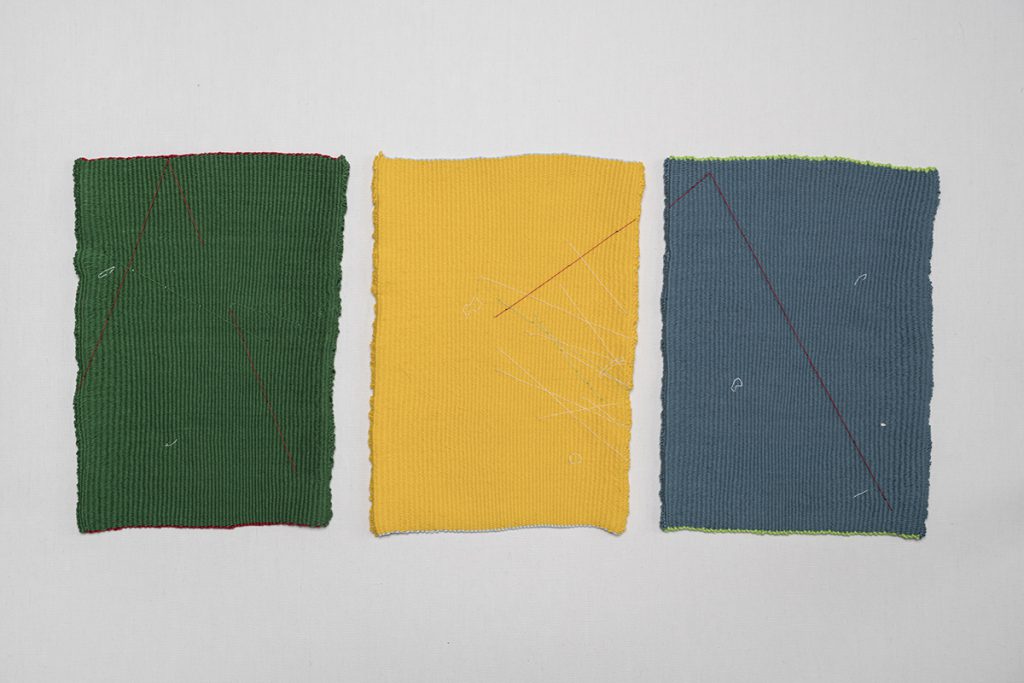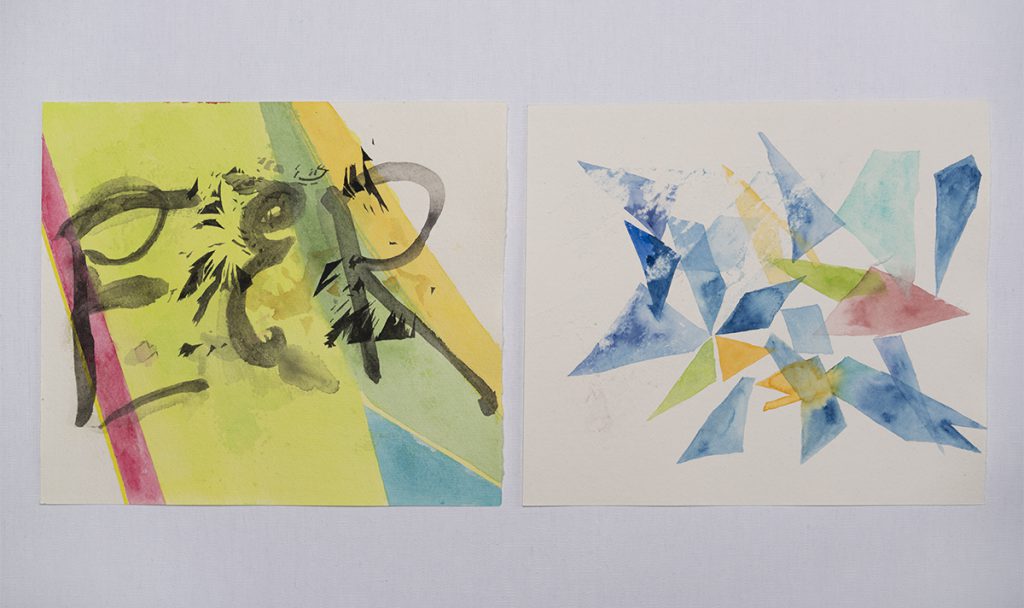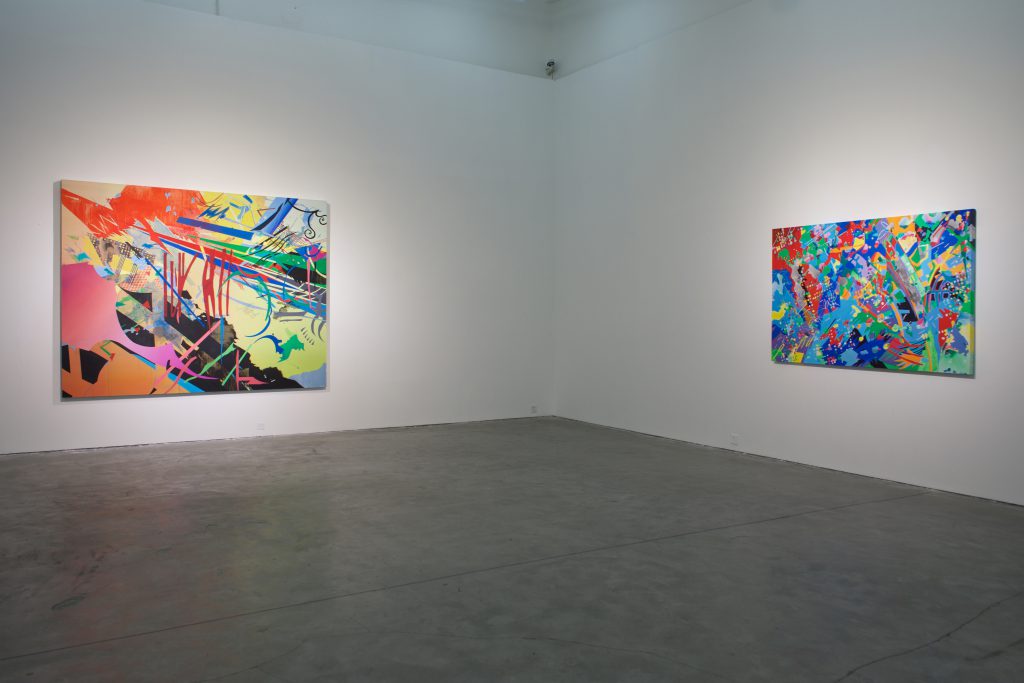内外交织中的复调——毕蓉蓉《小说景观》
Weaving Interior to Exterior: Bi Rongrong’s Fiction Landscape
Text by Sara Yuanjing, translated by R. Orion Martin
文:袁璟 翻译:马睿奇
January 2017
2017年1月
Exhibition link: Fiction Landscape
展览链接:小说景观
He is that living being who, from within the life to which he entirely belongs and by which he is traversed in his whole being, constitutes representations by means of which he lives, and on the basis of which he possesses that strange capacity of being able to represent to himself precisely that life.
– Michel Foucault, The Order of Things, p381
人是这样一个生物,即他从他所完全属于的并且他的整个存在据以被贯穿的生命内部构成了他赖以生活的种种表象,并在这些表象的基础上,他拥有了能去恰好表象生命这个奇特力量。
[1] 米歇尔·福柯 《词与物》莫伟民译 ,上海三联书店出版,2001,P459-460
From a Stone age totemic wall of witchcraft or a Han dynasty fabric motif to a piece of earth discovered upon stepping out of an art museum, graffiti on the wall of a Manchester barber, or posters on the streets of Berlin: Bi Rongrong takes in these elements like a snapshot photographer, only to later enlarge and reconfigure them.
石器时代用于巫术的一块图腾墙、汉代织物中的一片图纹、甚至是刚参观完美术馆走到门外看到的那块地面、曼城理发店外墙上的涂鸦、柏林街头的海报,毕蓉蓉就像是个快照摄影师一般汲取着自己所看到的所有图案,放大而后“撕碎”。

《Fiction Landscape-Overlapping Fabric 2》|《小说景观-重叠的织物二》
material: oil paint on canvas|材料:布面油画
1.2×1.8m, 2016, 7
Fragments and Traces
In an era of visual deluge, we are hard pressed to distinguish whether the remnants of images left in our minds are complete or merely a portion of the whole, perhaps even impressions that were distorted of their own accord. This act of discernment is fully overlooked and unexamined in our hectic lives. As she intuitively makes use of this subtle process, Bi Rongrong uses substantive creative gestures as a form of restoration.
However, these restored fragments of the real world become equivalent when divorced from the symbolic and existential contexts they previously occupied. That is to say, both ancient artistic diagrams of established artistic worth and the anonymous street graffiti are autonomous individuals, lifeless. Only when paired with language are they infused with life, and this linguistic construction is the creative method that Bi Rongrong employs.
碎片、纹样
在这个图像泛滥的时代,我们已经难以分辨脑中残留下来的影像,究竟是完整的,还是仅仅是部分的、甚而是经过自身意向扭曲的景象,这个过程在匆忙度日之中完全被忽视并且未被体察。她便是这么自然地将这个微妙的过程,用具体的创作行为进行还原。
然而,被还原的现实世界的这些碎片,因其剥离了原本的象征意义和存在环境,而变得等价。也就是说无论是被认为极富艺术价值的古代艺术图样,还是街头无名者涂鸦的形状投射,都是孑然的独立个体,没有生命。只有当它们被赋予语言之后,它们才会彼此鲜活起来。这一“语言”的构建,便是毕蓉蓉的创作过程。
Weaving
Bi Rongrong selected fabric as her material and carried out her expression using laser-cut and hand-woven cotton thread and fabrics. These choices embody her interest in materials and languages beyond painting. The act of weaving may be an unconscious activity she performs in moments of self-reflection, yet it became an integral part of her personal language of expression. Upon looking at Bi Rongrong’s work, we have a pure intuition of the flowing, rhythmic combinations of line, color, and point. But in addition to these, there is also the rational dimension of “What for?” that reverberates through the work. For Bi Rongrong, however, this question becomes, “Why not?” or “What if?” It is this inquisitive impulse of constant questioning that enriches her work. In addition to the large-scale paintings she has made before, this exhibition also features a video work and several woven installations. In combination with the distinct attributes of the space, the audience can’t help feeling a swell of anticipation when rounding a corner.
编织
毕蓉蓉选择了织物这一素材,利用激光切割和手工编织的棉线、布料等等进行表现,这体现出她对于绘画之外的材料及语言的兴趣。“编织”这一行为或许是她面对自身感知时,下意识的行为,却让这一形式得以成就自身的语言。当我们观看她的创作时,除了纯粹地感受线条、色块、点的流动、节奏,理性层面的“为什么”还是会不时响起。到了毕蓉蓉这里,这个问题则变成了“为何不(Why not)”或者是“又怎样(What if)”,正是这种不断发问的好奇和动力,让她的作品愈现丰富。这次展览的作品除了一如既往的大幅油画创作,还有视频、织物作品的装置等等,再加上空间的属性,让人在转角时不由心生期待。

A detail of the Fiction Landscape |《小说景观》展览现场之局部
Left左:《Fiction Landscape-Blue Fabric|小说景观-蓝色织物》
material: Laser cut on fabric| 材料:布面激光切割
1.92×0.8m, 2016.10
Right右:A Detail of Installation|装置局部《Fiction Landscape-Overlapping Fabric 4|小说景观-重叠的织物四》
2016.11
Foremost in artistic expression is to map the real world onto canvas; second is to reflect the activity and emotions of the creator’s inner world. This is how Bi Rongrong wanders between interior and exterior, combining her own experiences with various elements drawn from the real world. In the video work Fiction Landscape, the fragments Bi Rongrong has selected clearly impress upon us the sensation of sitting in a rumbling train car, filming the landscape through an adjacent window. The scenery beyond the window streaks past, blurring into indistinctness. As she chooses what to take in or pass over, fragments seem to rise out of her memory involuntarily. Superimposed on the landscape beyond the window, they ultimately return us to a linear rule.
艺术表现其一是将现实世界映射在画布之上,其二则是反映作者内心世界的活动和情感。她就是这样游走在内与外之间,将自身的经验与来自现实世界的种种相互融合。在《小说风景》这个视频作品中,我们能够清晰地感受到,坐在飞驰的火车内,隔着窗户拍摄的风景,与她选择的碎片之间的呼应。窗外的风景疾速向后,而使一切变得模糊,对此她选择接受、放任,而记忆中的碎片仿佛无意识般地出现,与窗外风景重叠,并最终归于某种线性的规律。

视频/Video: 《小说风景/Fiction Landscape》
03‘12“
2016
On the one hand, Bi Rongrong is attracted to the beauty of a rule-based tidiness. The canvas is composed according to a certain set or rules, or simply collaged together from cut pieces of paper, and the implicit spaces “between the lines” reveal a pure beauty that is akin to a basso continuo. On the other hand, an internal drive compels her to seek breaking points in this constructed tidiness. “Rules are made to be broken” may be one of the main reasons she selected weaving. It is based on set rules that, through the labor of simple repetition, create the background of a woven work. And yet traversing between the chaotic threads and the vibrant colors of the lines, we seem to detect a certain agreement in this restless heart. Of course, it may simply be that under the constraints of such regulations, there are times when the only product is static.
毕蓉蓉一方面被规则带来的工整之美所吸引,按照某种规律织成的布料,或者是用最简单的交叠方式将切割后的画纸结合起来,这其中暗藏的“弦外之音”(between the line)透露着类似于通奏低音一般的净美。而另一方面,内心深处的力量又驱使她在这工整之中寻找某个“破坏”的点。“规则便是用来打破的”或许恰恰是她选择编织物的根本原因。依据特定规则,通过简单重复的劳动打造出来的编织物作为背景,而杂乱的线头、跳跃的艳色线条穿梭其间,人们仿佛看到某种约定之下不安分的内心,抑或是在规则约束之下,偶然出现的“噪音”。

《Fiction Landscape-contour 8|小说景观-轮廓八》
material: cotton thread|材料:棉线

《Fiction Landscape-contour 9|小说景观-轮廓九》
material: silk screen print on paper, cotton thread|材料:纸本丝网印刷,棉线
53×33.5cm,2016, 06
Similarly, we can clearly distinguish some forms within her paintings, such as the bird totem in Fiction Landscape – A Stone Wall or the symbols in Fiction Landscape – Flowers of Holland. Others, however, cast doubt on a singular relationship between noun and object. It is impossible to fathom the origins of some depicted forms. These fragments of reality break down our concept of a known, established world. They are pathways through which to break from a chrysalis, and they reveal the conflict between Bi Rongrong’s external and internal worlds. There is a tension between her powers of destruction and self-control that corresponds to the contradictory tensions of the world at large, and these multiple points of conflict are superimposed and compressed into the work. Her personal journey, a movement through interior and exterior realms, is woven into the images. As such, we can see how erratic lines, points, and surfaces augment her tidy patterns. The clash of colors on the canvas creates a deep impact, but in actuality, the seemingly chaotic pictorial space adheres to its own rules, rules originating in Bi Rongrong’s balancing of control and destruction. At the same time that she “destroys,” she is consistently maintaining control. This is no different than when she allows the brush grow and develop (shengfa) on its own. At times, Bi Rongrong will pause because “the feel of it isn’t right.” This feeling marks a turning point in the balance of control and destruction.
同样地,在她的画中有些形状我们或许可以清晰地辨认,比如《小说景观—一片石墙》中鸟的图腾,《小说景观—荷兰的花》等,然而却又会对于名词与物体之间这种唯一的对应关系心生疑惑。有些形状我们则无从想象它们来自何方。用来自现实世界的碎片来打破我们既知的、认定的世界,是一种从内里破茧而出的途径,也正显示出她内心与外在的冲突。她自身控制力和破坏力之间的冲突,对应于外在世界的矛盾冲突,这多重的冲突被她重叠囊括在作品之中。她的个人旅途,即内在与外在间游走的过程,被编织在了一张图景之中。于是,我们会看到工整的纹样与信手拈来的线条、点、面重叠在一起,相互冲突的颜色在画布上强烈撞击。看似混乱的画面实际自有其章法,而这章法则来自她对控制与破坏这两极的平衡。她在“破坏”的同时,也在进行连续的控制,就像她在任由画笔“生发”的时候,有时也会因为某个“感觉不对的时刻”停顿下来,而这种不对的感觉便是控制与破坏产生不平衡的拐点。

《Fiction Landscape-A Stone Wall|小说景观-一片石墙》
material: oil paint on canvas|材料:布面油画
30x40cm,2016.5
Polyphonic Fiction
In the development of human cognition, observations precede language. We first use our eyes to perceive the world, then confirm our perceptions when we have grown accustomed to language. Bi Rongrong’s custom, similarly, is to first create a work, then affix a name to it. This illustrates yet again that she is a creator who emphasizes perception. Fiction Landscape is a most appropriate appellation for these works. Simply speaking, the production of fiction also requires that fragments of reality are intercepted and then superimposed or fused with various tensions. As a result, both the novel and the work of Bi Rongrong demonstrate a certain fictional reality that transports us to a landscape we would be unable to experience in our lived reality.
If we were going to classify Bi Rongrong’s “fiction,” we would first think of Bakhtin’s polyphonic fiction. In Bakhtin’s view, only through a multitude of independent and incompatible voices and identities is a true polyphony created from the amalgamation of valuable, distinct voices. This is the starting point of polyphonic fiction. Furthermore, dialogue permeates polyphonic fiction, for the composition of the novel is based in conversational relationships.
复调小说
一如人类认知发育的过程,观看先于语言。我们首先用双眼感知世界,在习得语言后,再对自己的感知进行确认。毕蓉蓉的惯例同样是先有了作品的创作,再冠以名字,这也从另一个侧面显示出她是一位感知先行的创作者。《小说景观》是对这组作品最恰如其分的表达了。简单来讲,小说的创作同样截取现实世界的碎片,将各种冲突矛盾进行叠加融合。于是,小说和她的作品同样都是呈现了某种虚构的现实,却带给我们在自身所处的现实中无法体察的景观。
而如果要对她的“小说”进行某种归类的话,首先想到的便是巴赫金提出的“复调小说”。
在巴赫金看来,“有着众多的各自独立而不相融合的声音和意识,由具有充分价值的不同声音组成真正的复调——这是复调小说的基本特点”。而且,“复调小说整个渗透着对话性,小说的结构的所有成分之间,都处在这对话关系中。”[1]
[1] 巴赫金著,《巴赫金全集5-陀思妥耶夫斯基诗学问题》,白春仁 顾亚铃译,河北教育出版社,1998年

《Fiction Landscape-Fabric 3|小说景观-织物三》
material: watercolor on paper|材料:纸本水彩
25×21.5cmx2
2016, 05
In Bi Rongrong’s work, those fragments that she selected while traveling play the main role in this polyphonic fiction. They possess independent voices, but their interactions generate intertextuality when coordinated by the author. This mutual reference, dialogue, and permeation creates a boundless network. At the same time, these elements remain independent and retain the power to self-initiate. Each of them exists in this network in a dynamic state of constant expansion. This allows the works to establish an open composition that is welcoming to the incorporation of new elements.
For example, in the installation Fiction Landscape – Overlapping Fabric 4, Bi Rongrong uses the extremely soft material of silkscreen fabric. She embroiders upon this silk a regular pattern and some points and lines that appear to be randomly formed. The work itself changes when hung for an exhibition. The interacting locations of the four works create subtle changes in the space, yielding a certain form “dialogue.” Light projected on the wall lends the entire work a certain uncertainty that teeters on the edge of unbalanced. It is the power of expansion generated by this fraught situation, paired with the supple cloth, that makes this set of works the “treble” of the exhibition.
相应地,在毕蓉蓉的作品中,那些从旅途中截取的碎片恰恰扮演了这种“复调小说”中的主体,它们有着各自独立的声音,并且在作者的统一调配下,形成了相互之间的“互文性”,彼此之间相互参照、对话、渗透,形成一张巨大的网络。与此同时,这些元素因其独立,而拥有着自我生发的能量,它们每一个在这张网络中都是动态的,不断地蔓延着。于是,这些作品完成了一个开放的结构,始终准备着迎接新的元素加入。
例如,在装置作品《小说景观—重叠的织物四》中,她采用了丝网布这一极为柔软的材质,上面绣有规则的纹样和一些看似随机的形状点线,悬挂展示的方式使作品本身便发生了变化。而四件作品相互之间的位置也会因为空间的细微变化而产生“对话”,再加上映射在墙面上的光影,这些都让整个作品处于一种不稳定的、濒临失衡的状态。恰恰是这种紧张状态与柔软的布面之间形成的蔓延的力量,使这组作品成为展览的“高声部”。


Installation |装置《Fiction Landscape-Overlapping Fabric 4|小说景观-重叠的织物四》
mixed material installation (silk screen cloth, laser cut on fabric,laser cut on stainless steel, wood, fabric, video, sound, etc.)
综合材料装置(丝网布,布面激光切割,不锈钢激光切割,木头,纺织品,视频,声音等)
dimension variable|尺寸可变,2016.11
It is worth mentioning that the reverberating background music is a sonic element that carries through the entire exhibition, creating a series of harmonious effects among the visual works. Emanating from the audio of the video work Fiction Landscape, a reverberating bass line is complemented by another audio track that corresponds to the rhythms of the visual elements. Recalling Bakhtin’s comment that a church may be the most suitable physical space for polyphonic novel, we could say that this background sound is no different than that found upon entering a church: it leads one into a specific realm where one can hear the sonic identities that are present there.
值得一提的是,展览现场始终回荡的背景音乐作为声部之一,也在一众视觉作品之中起着调和的作用。从视频《小说风景》中的一层声音元素展开,在一个始终回旋的低音伴奏之上,加上了多元变化的另一个音轨,恰好回应了视觉所接触的元素各自生发的节奏。如巴赫金所说,教堂也许是最为符合复调小说特点的具象空间,那么这里的背景声音也可以说是人们进入教堂时听到的声音一般,带领着人们进入这个特殊的场域,聆听其中存在的各种声音和意识。
The 17th century ink painter Shitao said, “Painting is the result of the receptivity of ink: the ink is open to the brush; the brush is open to the hand; the hand is open to the heart; all this is the same way as the sky engenders what the earth produces; everything is the result of receptivity.” Bi Rongrong has a deep relationship with traditional Chinese landscape painting, and although her works are not limited to any single media, the spirit of landscape painting appears to have impressed itself upon her. Her reflexive attitude brings her into contact, and allows her to accept the diversity of her era and all of its contradictions. She is constantly collecting various realities and fragments of memories. Within these fragments, she coexists with the boundaries of an objective life. To her, the different phases of her life are also different phases of spiritual growth. And as for the observer, in this alternate realm, the feeling of a blooming coexistence harkens back to the existence of a now withered common body.
“画受墨,墨受笔,笔受腕,腕受心。如天之造生,地之造成,此其所以受也”。17世纪的山水画家石涛写下这样的语句。与山水画有着深厚渊源的毕蓉蓉,尽管其作品已不受限于何种媒介,但这种来自于山水画的精神大约就这样一直积存心间吧。她便是以这种自然而然的态度来接触并接受这个自己时代充满矛盾的多元性,不断地收集各种现实的、记忆的碎片,在这些碎片中,她与这个客观生活中的不同界域共存,对她来说,是她生活道路的不同阶段,也是她精神成长的不同阶段。而于观者,在这不同的界域中,所萌发共时同存的感觉似乎能够唤起早已零落的共通体的存在。



The exhibition view of Fiction Landscape|展览《小说景观》的现场
A Thousand Plateaus Art Space|千高原艺术空间
2016, 12, 17—2017, 02, 28